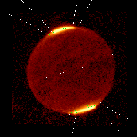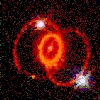 Aurora on Jupiter
Aurora on Jupiter
Other MagnetospheresFor instance, Jupiter's "planetary magnet" is about 20,000 times stronger than the Earth's, and its radiation belt is not just more extensive than the Earth's but also more intense. Jupiter has an aurora, pictured above as observed by the Hubble Space Telescope (click here for small image; for a bigger version, click here). Jupiter's large moon Io was found to have a remarkable "dynamo interaction" with the planet (details here), and Jupiter's magnetosphere has many modes of radio emissions, first observed in 1955 and still not well understood. As for the rest of the solar system: Venus appears to be unmagnetized, and the solar wind penetrates all the way to an "ionopause" above its dense atmosphere. In September 1997 Mars was found by "Mars Global Surveyor" to a weak magnet--just magnetized in patches, though some of them were moderately intense. Tiny Mercury, visited three times by Mariner 10 in 1974-5, is also magnetic, although its magnetosphere is so small that long-term trapping probably does not occur in it. Mariner 10 did see on its night side what appeared to be an abrupt acceleration event, perhaps similar to a substorm. The "Messenger" spacecraft, currently on its way, is due to reach Mercury in 2008 and attain an orbit around it in 2011.
Cosmic RaysThe Sun, stars and the distant visible universe are mostly plasma, and it turns out that like the magnetosphere, they too can contain high-energy particles, some of them energized above and beyond the levels found in the Earth's magnetosphere. The earliest evidence came from cosmic rays, discovered in 1912 by Victor Hess. It was already noted here that matter conducts electricity only if its ions or electrons (or both) are free to move. Molecules of air hold on to their electrons rather tightly, so that air is an excellent electric insulator. Only the high voltage of lightning can force a current through it! But the insulation is not perfect: in the late 1800s, scientists were puzzled by the ability of electric charge--e.g. on a charged electroscope --to gradually leak away through the air. The discovery of radioactivity in 1895 provided an explanation: traces of radioactive elements in the ground emitted fast particles and gamma rays, and these tore electrons off atoms--temporarily, true, but it was enough to support a small leakage current. Strangely, however, the effect seemed more pronounced atop high mountains. Victor Hess took his instruments aboard a balloon, and noticed that the higher the balloon rose, the greater was the leakage rate. Obviously, whatever radiation was responsible came not from the ground below but from space above, and it was therefore named "cosmic radiation." The higher the balloon flew, the less of the atmosphere the observed radiation had to pass through, and the more intense was its effect. Early researchers thought that the radiation consisted of gamma rays, the most penetrating type then known, but it turned out to be affected by the Earth's magnetic field, suggesting charged particles. After World War II unmanned balloons were used to lift special photographic emulsions to the top of the atmosphere, to observe the "primary radiation" (on the ground we get mostly fragments from its collisions). They found that it consisted of the ions of common matter--mostly hydrogen, some helium, lesser amounts of heavier elements, in proportions not radically different from those found on the Sun, but their energies, compared to those of atoms and ions elsewhere, were enormous. How enormous? One yardstick for measuring the energy of motion ("kinetic energy") carried by a fast ion or electron of mass m, is the "rest energy" E = mc2 assigned to the particle by the theory of relativity. The kinetic energy of a satellite in a near-Earth orbit (having ten times the speed and, weight for weight, hundred times the energy of a rifle bullet) is just a tiny part, less than one billionth of its mc2. For the slowest cosmic rays, on the other hand, the energy of motion is about equal to mc2, while at the top of the observed range it is at least a billion times larger.
How do cosmic rays gain such tremendous energies? In truth we don't know, although theorists tend to credit supernova explosions, which produce powerful expanding shock fronts. The figure above, taken by the Hubble Space Telescope, shows the remnant of such a supernova, observed in 1987, and the small bright circle is its spreading shock (the bigger circles must have been emitted earlier). It is hard to check out such theories, and the directions from which cosmic rays arrive do not tell anything, for they cover the sky evenly, having been thoroughly scrambled by galactic magnetic fields. Shock acceleration can however be observed in the Earth's magnetosphere, e.g in the remarkable event of March 24, 1991, and that suggests our nearby "space plasma lab" may have something to say about cosmic rays, too. The Birth of a Radiation Belt on 24 March 1991
High Energy Particles from the UniverseHigh-energy particles in distant space also announce their presence through x-rays and gamma rays. Like all electromagnetic waves (including light) these radiations can only transmit their energy in well-defined packets, known as "photons." Each photon is furthermore emitted by a single particle, and since the photons of x-rays and gamma rays are rather large, particles that emit them need a hefty amount of energy to begin with. Some distant sources of x-rays and gamma rays emit very brief and quite intense bursts of radiation, confronting astronomers with yet another mystery.
Fast Particles from the Sun
The Sun also accelerates electrons, apparently in greater numbers but to lower energies. Being lighter, they are more tightly held by local magnetic field lines and often, unable to escape, they produce intense bursts of x-rays. The figure above, from the Japanese Yohkoh satellite, gives the image of such an x-ray emission, at the top of an arching bundle of field lines. Solar energetic ions were first observed in the 1940s, and the ideas of magnetic reconnection and its release of magnetic energy were originally formulated to explain their existence. Unfortunately, reconnecting field lines are invisible, and the region where reconnection is supposed to happen on the Sun is hard to observe. It may therefore be quite relevant that similar processes have been observed in substorms in the magnetospheric tail. True, substorms are still a puzzle, too, but at least they take place within reach of scientific satellites.
|
 More about other magnetospheres
More about other magnetospheres Remnant of Supernova 1987
Remnant of Supernova 1987 More about cosmic rays
More about cosmic rays More about distant sources of fast particles
More about distant sources of fast particles Yohkoh image of x-rays from a magnetic arch
Yohkoh image of x-rays from a magnetic arch More about fast particles from the Sun
More about fast particles from the Sun